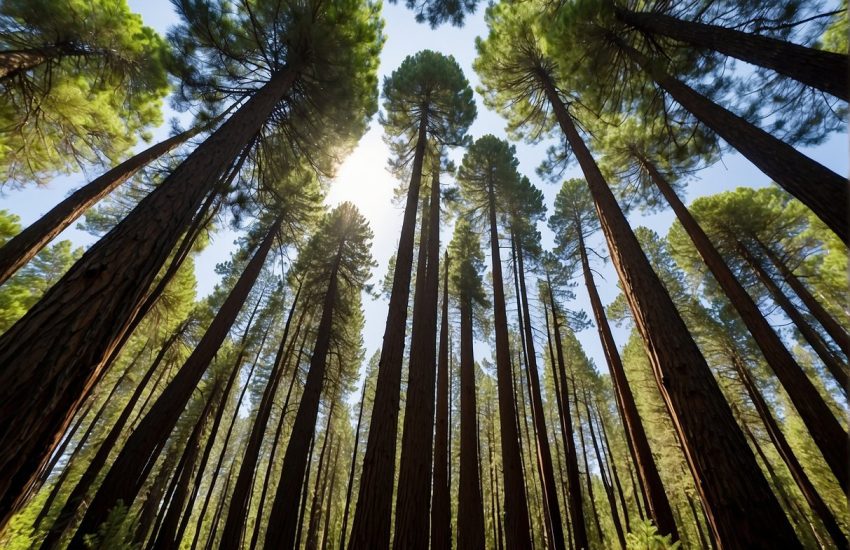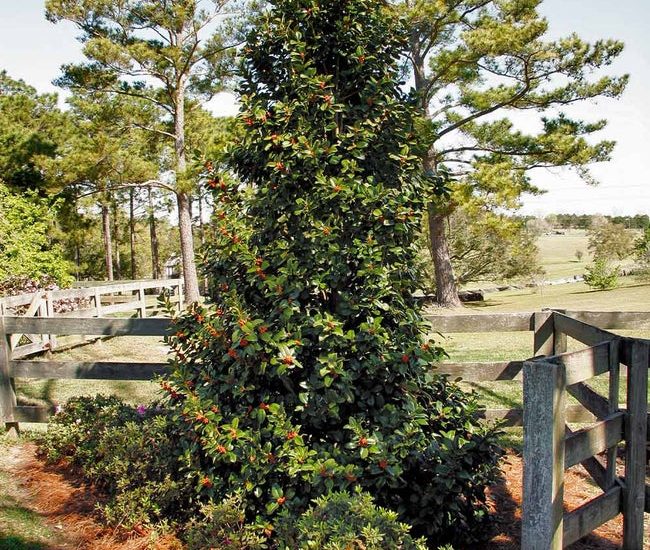The Best Evergreen Trees to Grow in Arizona
The most widespread perception of Arizona's terrain is that it is composed of a low-lying desert covered in the state's famous Saguaro cactus and hardy shrubs. Planting desert trees is a terrific way to get the low-maintenance beauty you've been wanting, whether you're looking for a way to add shade, color, or curb appeal to your Arizona yard.
Since Arizona's USDA growth zones range from 4b to 10b, gardeners have many options when picking evergreens to plant in their yards. Arizonans have access to a wide variety of evergreen trees to spruce up their residences and places of business. The fact that these trees provide pleasant relief from the blazing sun makes them suitable. Additionally, you can plant them in certain areas to increase privacy on your property.
15 Evergreen Trees to Grow in Arizona
Evergreen trees retain their leaves throughout the year. Thus, their foliage can give year-round wall-to-wall seclusion. Evergreens have a regular appearance as they age, making them the perfect privacy screen.
More than merely a private yard is created by them. Evergreen trees also reduce background noise. These 15 evergreen plants can be grown in Arizona.
1. African Sumac
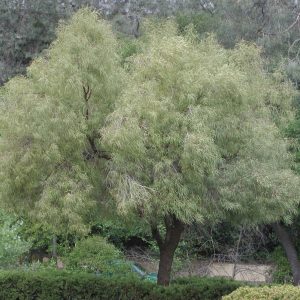
The highly resilient African Sumac tree can go for extended periods without water. Although this tree can be found all over the southwest desert, it is most prevalent in the Sonoran Desert. It thrives in light soils with gravel or exposed rocky outcrops, which makes it the perfect plant to grow in a container. The leaves of this tiny tree are one inch long and vivid green. The tree has a narrow trunk and twisted branches that mix gray and brown.
2. American Arborvitae
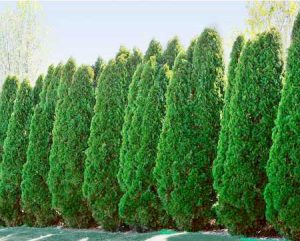
An 80-foot tall, evergreen conifer, the American Arborvitae is also referred to as the Northern White Cedar. It features cones that are about an inch long and colored green. This tree does best along riverbeds and stream banks, where it may quickly receive 6 to 8 inches of annual rainfall.
The trees can survive intense forest fires and are wind resistant. Although the wood is thought to have a relatively high density, neither its durability nor its suitability as firewood prevents it from being used for construction. This tree grows well in the USDA Hardiness Zones 3 through 7 when the soil fertility is low and the annual rainfall ranges from 20 to 30 inches.
3. Arizona Cypress
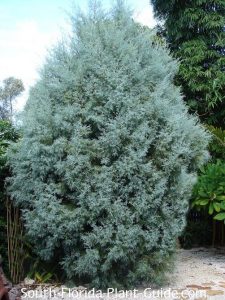
The benefits of using the Arizona Cypress, commonly known as the Blue Nugget, for medical purposes have long been understood by Native Americans. This tall evergreen can reach heights of up to 60 feet and has flat, as opposed to spherical, needles. The bark has a reddish- brown tint and sharp ridges that etch patterns resembling diamonds throughout its surface. The leaves and twigs of Arizona Cypress trees can be soaked in boiling hot water to form a tea that lowers fever, and the trees also generate a highly fragrant resin that can cure coughs and colds. Native Americans make fire-starting bundles out of the leaves and needles to produce hot coals; the roots are dried and used for various purposes.
4. Mulga
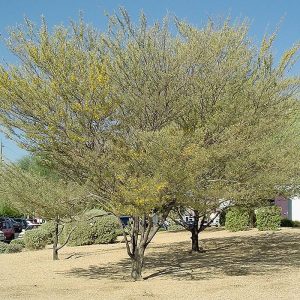
The Mulga tree can be found in Africa, Asia, the United States, and Australia. It is a tiny tree that can reach a height of 30 feet and has three-quarter-inch long, brownish-green blooms. Its limbs are clothed in lush foliage and have compound leaves with thin, green thorns.
This tree thrives in arid environments with stony, unfertile soil. This tree may reach a depth of 35 feet with its long, spade-shaped roots, which aid it in finding water during dry spells. Because of its shallow roots, it thrives when planted among other evergreens like pines.
5. Texas Olive
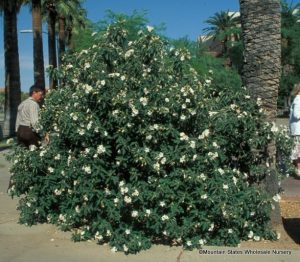
A medium-sized evergreen, the Texas Olive tree can reach 40 feet on a single branch. It has slender green foliage and blooms from February to April with five-petal white flowers. Although the fruit from the tree is edible, it is better not to eat it because the seeds inside have been known to cause significant health issues if consumed.
The Texas Olive tree can withstand severe droughts and is ideal for arid areas where water usage must be minimized. It only needs 4 inches of rain every year to survive. When the yearly average temperature is between 70 and 80 degrees Fahrenheit and lows are often below 40 degrees Fahrenheit, this evergreen flourishes in USDA Hardiness Zones 9 through 11.
6. Arizona Madrone
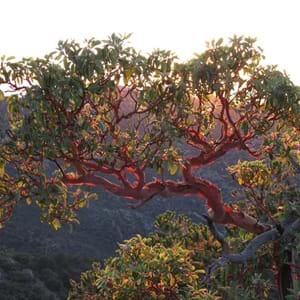
The Strawberry Tree is another name for the Arizona Madrone. It has a single straight trunk, one straight branch on top, and deformed branches with reddish bark. It is said to be a little evergreen tree that develops exceptionally slowly. This tree's leaves change color with the seasons, turning from dark green in the summer to yellow or orange in the fall before they drop from the tree.
Although the bright red fruit from the Arizona Madrone is harmful to humans, wildlife finds immense value in it. The berries can be used to make jams and jellies and have a high vitamin C content. This evergreen flourishes in USDA Hardiness Zones 3 through 10, where annual precipitation ranges from 20 to 30 inches.
7. Rocky Mountain Juniper
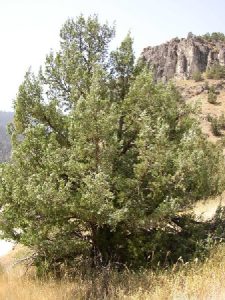
The Rocky Mountain Juniper is an evergreen that grows slowly and reaches a height of 40 feet. Its short, waxy needles have a blue hue that blends the tree with its surroundings. This evergreen's limbs droop as it ages, and the bark is reddish brown and flaky.
Native Americans can use this tree in a variety of ways. Its wood is used to build tepees, and the bark contains a substance that may be transformed into turpentine, which has a variety of uses. This tree's needles are also edible; eating them will provide you with vitamin C.
8. Desert Ironwood
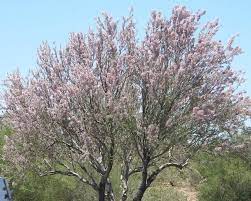
The Desert Ironwood is an evergreen tree with green, 3/4-inch-long leaves that can reach heights of up to 30 feet. It produces vivid red berries from its creamy white bell-shaped blooms. This tree can survive on rocky, infertile soil but needs at least 6 inches of annual water. One specimen of this slowly growing evergreen, which can live for 2,000 years, is thought to be the longest-living tree in North America. Because this tree doesn't start producing seeds until it is roughly 20 years old, it is common to find old specimen.
This tree's wood can withstand high temperatures, making it ideal for Arizona, and it also contains substances with anti-inflammatory effects.
9. Colorado Pinyon
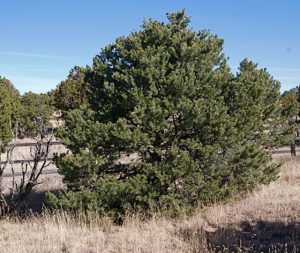
The Colorado Pinyon tree is a slow-growing evergreen with twisted branches and tiny green needles that can grow up to 50 feet tall. Separate trees that bear male and female flowers develop grayish-brown as they age. While the female flowers produce the tasty pine nuts that give this plant its name, the male flowers generate pollen.
Protein, fiber, and monounsaturated fatty acids, or "healthy fat," are all in large amounts in pine
nuts. In USDA Hardiness Zones 4 through 9, this evergreen flourishes when the yearly average temperature ranges from 45 to 65 degrees Fahrenheit.
10. Texas Ebony
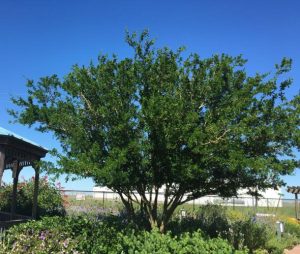
The Texas Ebony is a tiny, evergreen tree with a spread of up to 40 feet and a height of around 30 feet. It has waxy, waxy-coated, dark green leaves that mature to a grayish-brown color. This tree's bark includes substances used to treat cancer, inflammation, respiratory issues, and pain. Texas ebony, which can resist temperatures of -20 degrees Fahrenheit, is regarded as the most cold-tolerant ebony species in the world. Although it can easily survive in the desert, this tree needs at least 6 inches of moisture each year to grow and thrive. Treating cancer, asthma, depression, high blood pressure, inflammation, sleep disturbances, and tuberculosis are just a few potential medical uses for Texas ebony.
11. Honey Mesquite
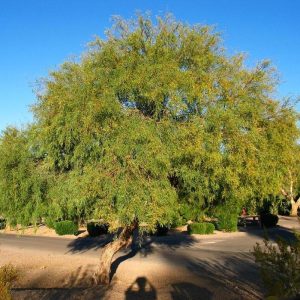
The thick Honey Mesquite can reach heights of 30 to 40 feet and a spread of 50 feet. Compound leaves with four to eight pairs of tiny green leaflets alternately up the stem. Older branches have small spines covering them, and the trunk's grayish-brown bark can get up to an inch thick.
Because honey mesquite trees are semi-deciduous and lose roughly half of their leaves in the summer when water is short, they can withstand prolonged droughts. Native Americans employed this evergreen for many purposes, including making dwellings, tools, and even musical instruments out of wood and using the bark to dye leather.
Native Americans in North America valued this tree as a primary food source because its beans and pods, which may be eaten raw or dried and crushed into flour, are high in protein. The bark includes substances known to relieve coughs and pain, and the wood is also used to manufacture fuel and charcoal.
12. White Fir
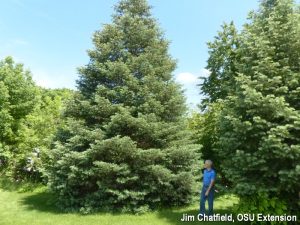
An evergreen, the White Fir can reach heights of 70 to 80 feet and a width of up to 50 feet. The tree gets its name from its flexible, one-inch-long, bluish-green needles with white undersides. When the tree is young, the bark is grayish brown; as it ages, it turns reddish brown.
White Fir trees can resist temperatures as low as -40 degrees Fahrenheit. Many Native American tribes used this tree for building materials and shelter since it can thrive in frigid regions. The wood's compounds, known for their ability to withstand fire, also help the wood survive flames.
13. Indian Laurel
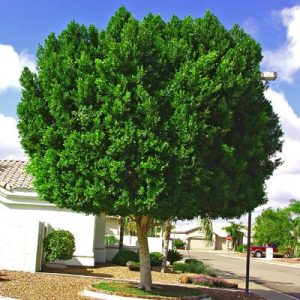
An evergreen with rapid growth that excels in arid climates is the Indian laurel. This medium-sized tree, native to Asia and Hawaii, may be trained to grow practically any size.
Glossy, dense, and pointed at the tip, the foliage has a rounded shape. Whether you use it as a shade tree or plant it in groups as a privacy hedge, it gives off a lush, tropical vibe. Once established, Indian laurels grow quickly, can withstand drought, and can be used as a sound barrier in urban areas due to their dense nature and ability to withstand pollutants. The light/medium gray of the bark will undoubtedly stand out in contrast to the other colors of the desert landscape.
14. Carob
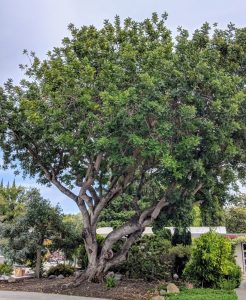
The Middle East and the Mediterranean are the native habitats of the carob tree. It is an evergreen tree with lateral roots, a deep taproot, a broad, hemispherical crown, and muscular branches.
The leaves are pinnate, alternating, and may or may not have terminal leaflets. It has been grown in the Mediterranean for its delicious seed pods, which have a chocolate-like flavor. The carob tree thrives in temperatures ranging from -6 to 50 °C, weak calcareous soils, and summer dryness. The landscape's nitrogen is likewise fixed by it.
Carob trees typically have male and female trees and are dicedious. Although bisexual types are available at some nurseries, females are typically cultivated for their up to 6" long delicious pods.
15. Cherry Laurel
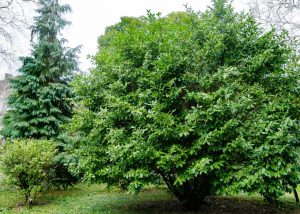
An evergreen shrub or tiny tree called a cherry laurel creates an excellent privacy screen. Although it is generally planted for its evergreen foliage, it also produces tiny, fragrant cream/white flowers that bloom in late winter to early spring and draw pollinators like butterflies and bees. The red berries that follow them draw several bird species.
Cherry laurels have a wide range of functions in the landscape since they may be trained into any shape. They may be cultivated anywhere from absolute shade to full sun. Some shade in Arizona's most challenging desert regions will help them thrive, whereas cooler upland regions will benefit from full sun.
Conclusion
Due to Arizona's environment, gardeners have a wide range of possibilities for growing evergreen trees with various traits. You may plant several evergreen trees in your backyard to enjoy year-round vegetation from your home, whether you live in the chilly uplands or the harsh low-lying deserts.

